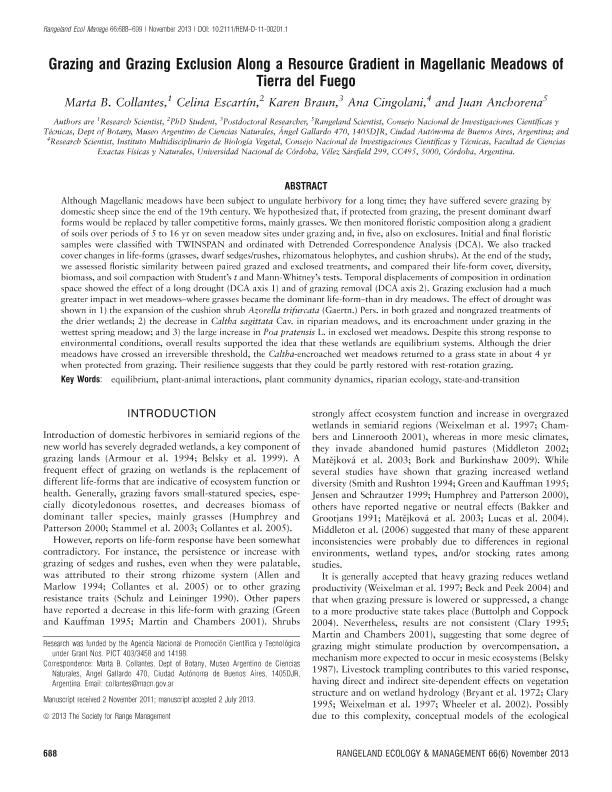Artículo
Grazing and Grazing Exclusion Along a Resource Gradient in Magellanic Meadows of Tierra del Fuego
Collantes, Marta Beatriz ; Escartin, Celina Andrea
; Escartin, Celina Andrea ; Braun, Karen; Cingolani, Ana María
; Braun, Karen; Cingolani, Ana María ; Anchorena, Juan
; Anchorena, Juan
 ; Escartin, Celina Andrea
; Escartin, Celina Andrea ; Braun, Karen; Cingolani, Ana María
; Braun, Karen; Cingolani, Ana María ; Anchorena, Juan
; Anchorena, Juan
Fecha de publicación:
09/2013
Editorial:
Society For Range Management
Revista:
Rangeland Ecology And Management
ISSN:
1550-7424
Idioma:
Inglés
Tipo de recurso:
Artículo publicado
Clasificación temática:
Resumen
Although Magellanic meadows have been subject to ungulate herbivory for a long time; they have suffered severe grazing by domestic sheep since the end of the 19th century. We hypothesized that, if protected from grazing, the present dominant dwarf forms would be replaced by taller competitive forms, mainly grasses. We then monitored floristic composition along a gradient of soils over periods of 5 to 16 on seven meadow sites under grazing and, in five, also on exclosures. Initial and final floristic samples were classified with TWINSPAN and ordinated with Detrended Correspondence Analysis (DCA). We also tracked cover changes in life-forms (grasses, dwarf sedges/rushes, rhizomatous helophytes, and cushion shrubs). At the end of the study, we assessed floristic similarity between paired grazed and exclosed treatments, and compared their life-form cover, diversity, biomass, and soil compaction with Student's t and Mann-Whitney's tests. Temporal displacements of composition in ordination space showed the effect of a long drought (DCA axis 1) and of grazing removal (DCA axis 2). Grazing exclusion had a much greater impact in wet meadows–where grasses became the dominant life-form–than in dry meadows. The effect of drought was shown in 1) the expansion of the cushion shrub Azorella trifurcata (Gaertn.) Pers. in both grazed and nongrazed treatments of the drier wetlands; 2) the decrease in Caltha sagittata Cav. in riparian meadows, and its encroachment under grazing in the wettest spring meadow; and 3) the large increase in Poa pratensis L. in exclosed wet meadows. Despite this strong response to environmental conditions, overall results supported the idea that these wetlands are equilibrium systems. Although the drier meadows have crossed an irreversible threshold, the Caltha-encroached wet meadows returned to a grass state in about 4 when protected from grazing. Their resilience suggests that they could be partly restored with rest-rotation grazing.
Archivos asociados
Licencia
Identificadores
Colecciones
Articulos(IMBIV)
Articulos de INST.MULTIDISCIPL.DE BIOLOGIA VEGETAL (P)
Articulos de INST.MULTIDISCIPL.DE BIOLOGIA VEGETAL (P)
Citación
Collantes, Marta Beatriz; Escartin, Celina Andrea; Braun, Karen; Cingolani, Ana María; Anchorena, Juan; Grazing and Grazing Exclusion Along a Resource Gradient in Magellanic Meadows of Tierra del Fuego; Society For Range Management; Rangeland Ecology And Management; 66; 6; 9-2013; 688-699
Compartir
Altmétricas



